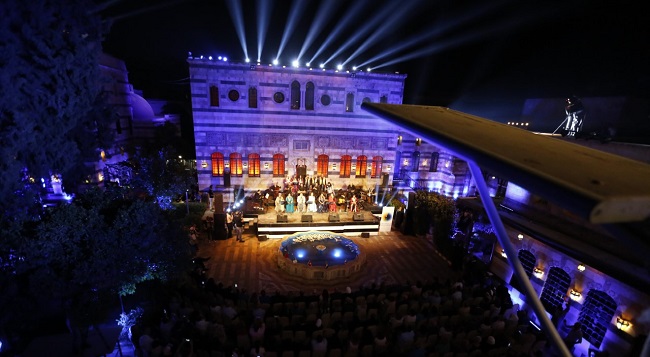Long exhausting years of war had passed before Damascus could witness such a gathering of many music gurus from all over the world. Azm Palace in the heart of Old Damascus hosted the second day of the demonstration “Muwashah Journey from Andalusia to Sham” organized by “Ain El Foun” foundation, under the patronage of Ministry of Tourism. It was a musical celebration of Muwashah (Andalusian classical chants) with the participation of singers and musicians from Spain, Morocco, Algeria, Tunisia, Lebanon and Syria. The concert included an amazing program with an opening piece entitled “Sayed Darwish” composed by Hussein Sabsbi.

Whereas, the first day of “Muwashah Journey from Andalusia to Sham” manifestation was a conference in Dama Rose Hotel, a cultural space which opened the door to many debates about the emergence of the art of Muwashah, which originated according to Saadallah Agha Al-Qalaa, Syrian former Minister of Culture, from the collective artistic awareness and interactivity between the arts of (architecture, music, poetry and rhythm). Aga refutes the theories of Muwashah origin to poetic rhythmic repetition along with geometric dimensions. Some theories say that Muwashah is adapted from Spanish Tropador songs, while others confirm its Oriental origins from Syria and Iraq.
Lebanese singer and researcher Ghada Shbeir, who holds a PhD in Music, teaches oriental singing. Ghada Shbeir has released several traditional Arabic CDs and Syriac chants in her efforts to preserve Syriac dialects from extinction. In addition to winning the first prize international award for her interpretation of Andalusian chants (Muachahat). “Muachahat went out of Arabic classical poetry verses rules, citing the Rahbani Brothers contributions in developing that art, by introducing Mawal into the structure of Muwashah, in Fayrouz songs.” She explained.
“Rahbani Brothers contributed as well in introducing Muwashah by female voices, after it was limited to male voices as still prevalent in Aleppo. They modified the musical distribution to be performed with an orchestra, which made the Muwashah more contemporary and acceptable to modern audience.” Ghada Shbeir detailed to Syriatimes.
 According to the Moroccan singer and researcher Samira Kadiri, Muwashah emerged as a kind of harmony between the Muslims, Jews and Christians cultures in Andalusia. Muwashah was a prelude to opera singing in Italy and France. Women contributions to Muwashah were a manifestation to their right to write poetry that glorifies pure virgin love, free from lust.
According to the Moroccan singer and researcher Samira Kadiri, Muwashah emerged as a kind of harmony between the Muslims, Jews and Christians cultures in Andalusia. Muwashah was a prelude to opera singing in Italy and France. Women contributions to Muwashah were a manifestation to their right to write poetry that glorifies pure virgin love, free from lust.
The concluding song came as a collective performance of the poem “My heart is prone to every image” by Ibn Arabi, composed by Taher Mamlli, with the participation of dancing band “Gulnar”. The concert ended with a collective performance of a piece of Andalusian heritage entitled “I adore an Andalusian girl” by all participants as an exquisite dream like celebration of muwashah long tour through the Umayyad Empire, launching from its capital Damascus to Andalusia, crossing Egypt and North Africa, and up to Granada.
The choice of Azm Palace, a historical monument and perfect location to host such grand celebrations; is a reminder of the famous Green palace from which Umayyad Empire was ruled. An event that didn’t only gather people from all over the world that appreciate the rich Syrian culture; but as well where all participants from Spain, Morocco, Algeria, Tunisia, Lebanon and Syria agreed on the (peace & love) message of this fascinating dream like concert celebrating Muwashah tour.
Interview & Report: Lama Alhassanieh

